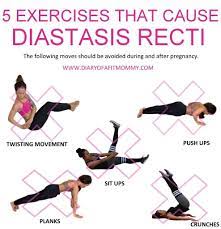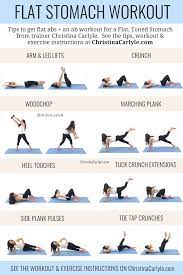Diastasis recti, a condition where the abdominal muscles separate during pregnancy or due to other factors, can be a common concern for many women. While it is important to consult with a healthcare professional before starting any exercise program, there are specific exercises that can help strengthen the abdominal muscles and potentially reduce the separation. In this article, we will explore some diastasis recti exercises that may be beneficial.
- Pelvic Tilts: Lie on your back with your knees bent and feet flat on the floor. Place your hands on your abdomen. Slowly tilt your pelvis back and forth, engaging your deep abdominal muscles. This exercise helps strengthen the transverse abdominis, which can provide support to the rectus abdominis muscles.
- Modified Plank: Start in a kneeling position with your hands placed shoulder-width apart on the floor. Extend one leg at a time behind you, keeping your body in a straight line from head to toe. Engage your core muscles by drawing your belly button towards your spine. Hold this position for a few seconds and gradually increase the duration as you feel more comfortable.
- Seated Leg Lifts: Sit on a chair or stability ball with good posture and engage your core muscles. Lift one leg at a time straight out in front of you while maintaining stability through your abdomen and pelvis. Repeat this exercise several times on each leg.
- Standing Side Crunches: Stand with good posture and place one hand on your hip while raising the other arm overhead. Slowly bend sideways towards the hand on your hip, engaging the oblique muscles on the side of your abdomen. Repeat on both sides for an effective workout.
- Heel Slides: Lie on your back with knees bent and feet flat on the floor. Slowly slide one heel along the floor until it is almost fully extended, then return it back to its starting position while maintaining engagement of your core muscles. Alternate legs and repeat.
Remember, it is crucial to perform these exercises with proper form and technique. Avoid any movements that cause discomfort or pain. Additionally, be patient with your progress as diastasis recti recovery can take time. It is advisable to work with a qualified fitness professional who specializes in postpartum exercise or seek guidance from a physical therapist who can provide tailored exercises based on your specific needs.
In conclusion, diastasis recti exercises can help strengthen the abdominal muscles and potentially reduce the separation between them. However, it is important to consult with a healthcare professional before beginning any exercise program to ensure it is safe for you. With patience and consistency, these exercises may contribute to improving the condition and promoting overall abdominal strength and stability.
5 Essential Tips for Diastasis Recti Exercises: Strengthen Your Core Safely and Effectively
- Start with low-impact exercises such as walking, swimming, and yoga to build core strength.
- Focus on breathing techniques during your exercise routine to engage the transverse abdominis muscle (TVA).
- Avoid heavy lifting or any exercises that involve twisting or arching of the back until you have built up a strong core foundation.
- Perform diastasis recti specific exercises such as planks, bird dogs, and pelvic tilts to strengthen the abdominal wall muscles and close the gap in your midline.
- Always consult with a doctor or physical therapist before beginning any exercise program to ensure safety and proper form for optimal results.
Start with low-impact exercises such as walking, swimming, and yoga to build core strength.
When it comes to diastasis recti exercises, starting with low-impact activities can be a wise approach. Engaging in exercises like walking, swimming, and yoga can help build core strength while minimizing the strain on the abdominal muscles.
Walking is a simple yet effective exercise that can be easily incorporated into your daily routine. It helps engage the core muscles, including the transverse abdominis, which provides support to the rectus abdominis muscles affected by diastasis recti. Start with shorter walks and gradually increase your duration as you feel more comfortable.
Swimming is another fantastic low-impact exercise option for individuals with diastasis recti. The buoyancy of water reduces stress on the abdominal area while allowing you to work on strengthening your core muscles. Swimming strokes that engage your abdominal muscles, such as freestyle or breaststroke, can be particularly beneficial.
Yoga is renowned for its ability to improve flexibility, balance, and core strength. When practicing yoga with diastasis recti, it’s important to focus on poses that avoid excessive strain on the abdomen. Modified versions of poses like cat-cow, child’s pose, and gentle twists can help strengthen your core without exacerbating the condition.
Remember to listen to your body and modify exercises as needed. If any movement causes discomfort or pain in your abdominal area, it’s essential to stop and consult with a healthcare professional or a qualified fitness instructor who specializes in postpartum exercise.
Starting with low-impact exercises allows you to gradually build strength in your core muscles while minimizing the risk of further separation or injury. As you progress and gain more confidence in your abilities, you can gradually incorporate other exercises specifically targeted towards diastasis recti recovery.
Always prioritize safety and consult with a healthcare professional before starting any exercise program. They can provide personalized guidance based on your individual needs and help ensure that you’re taking appropriate steps towards healing and strengthening your abdominal muscles affected by diastasis recti.
Focus on breathing techniques during your exercise routine to engage the transverse abdominis muscle (TVA).
When it comes to diastasis recti exercises, one important tip to keep in mind is the focus on breathing techniques. By incorporating proper breathing into your exercise routine, you can effectively engage the transverse abdominis muscle (TVA) and support the healing process.
The TVA is a deep abdominal muscle that wraps around the torso like a corset. It plays a vital role in stabilizing the core and supporting the organs. By consciously engaging this muscle during exercises, you can help strengthen and tone your abdominal area while minimizing strain on the separated muscles.
To engage the TVA, it’s essential to practice diaphragmatic breathing. This type of breathing involves inhaling deeply through your nose, allowing your belly to expand fully, and then exhaling slowly through your mouth, drawing your belly button toward your spine.
During each exercise, focus on maintaining this deep abdominal engagement. For example, if you’re performing pelvic tilts or modified planks, inhale deeply as you prepare for the movement and exhale as you initiate it. Visualize pulling your belly button towards your spine with each exhale, activating the TVA.
By incorporating proper breathing techniques into your diastasis recti exercise routine, you are not only targeting the superficial muscles but also strengthening and activating the deeper core muscles. This can help improve overall core stability and support healing of diastasis recti.
Remember that patience is key when recovering from diastasis recti. Start with gentle exercises and gradually increase intensity as advised by a healthcare professional or a qualified fitness expert who specializes in postpartum exercise. Always listen to your body and modify or stop any exercise that causes discomfort or pain.
Incorporating proper breathing techniques into your diastasis recti exercises is an effective way to engage the TVA and support healing. With consistency and mindful practice, these exercises can contribute to strengthening your core while promoting recovery from diastasis recti.
Avoid heavy lifting or any exercises that involve twisting or arching of the back until you have built up a strong core foundation.
When it comes to diastasis recti exercises, one important tip to keep in mind is to avoid heavy lifting or any exercises that involve twisting or arching of the back until you have built up a strong core foundation. This precaution is crucial for preventing further strain on the abdominal muscles and potentially worsening the condition.
During diastasis recti recovery, it is essential to focus on rebuilding and strengthening the deep core muscles, such as the transverse abdominis, before engaging in activities that put excessive pressure on the abdominal area. Heavy lifting, especially without proper core support, can strain the weakened connective tissue and exacerbate the separation of the abdominal muscles.
Similarly, exercises that involve twisting or arching of the back can place additional stress on the already compromised abdominal area. These movements can hinder proper healing and potentially lead to setbacks in your recovery journey.
Instead, prioritize exercises that target the deep core muscles without placing excessive strain on your abdomen. As mentioned earlier, pelvic tilts and modified planks are excellent options for engaging and strengthening these muscles while maintaining stability.
Remember, diastasis recti recovery requires patience and a gradual progression of exercises. It is crucial to listen to your body and not push beyond your limits. If you experience any pain or discomfort during exercise, it is advisable to consult with a healthcare professional or a qualified fitness expert who specializes in postpartum exercise.
By avoiding heavy lifting and exercises involving twisting or arching of the back until you have built up a strong core foundation, you can ensure a safer and more effective recovery from diastasis recti. Focus on strengthening your core gradually with appropriate exercises under professional guidance to promote optimal healing and regain abdominal strength.
Perform diastasis recti specific exercises such as planks, bird dogs, and pelvic tilts to strengthen the abdominal wall muscles and close the gap in your midline.
If you’re dealing with diastasis recti, specific exercises can be beneficial in strengthening your abdominal wall muscles and closing the gap in your midline. Incorporating exercises like planks, bird dogs, and pelvic tilts into your routine can help target the affected area and promote healing.
Planks are a fantastic exercise for engaging the entire core, including the abdominal muscles. Start by getting into a push-up position, but instead of resting on your hands, lower yourself onto your forearms. Keep your body in a straight line from head to toe and engage your core by drawing your belly button towards your spine. Hold this position for as long as you can while maintaining proper form.
Bird dogs are another effective exercise for diastasis recti. Begin on all fours with your hands directly under your shoulders and knees under hips. Slowly extend one arm forward while simultaneously extending the opposite leg straight back behind you. Focus on keeping your core stable and avoiding any arching or sagging in the lower back. Hold for a few seconds before returning to the starting position, then repeat on the other side.
Pelvic tilts are gentle yet powerful exercises that target the deep abdominal muscles, including the transverse abdominis. Lie on your back with knees bent and feet flat on the floor. Place your hands on your abdomen and slowly tilt your pelvis back and forth while engaging these deep muscles. This exercise helps strengthen and support the rectus abdominis muscles.
Remember, it’s essential to perform these exercises with proper form and technique to avoid straining or worsening diastasis recti. Start with low repetitions or shorter durations, gradually increasing as you feel more comfortable and stronger in those areas.
While these exercises can be helpful, it’s crucial to consult with a healthcare professional or seek guidance from a qualified fitness professional who specializes in postpartum exercise or diastasis recti recovery. They can provide personalized recommendations based on your specific needs and ensure you’re performing the exercises correctly.
Incorporating diastasis recti specific exercises like planks, bird dogs, and pelvic tilts into your fitness routine can be a step towards strengthening your abdominal wall muscles and closing the gap in your midline. Stay consistent, be patient, and listen to your body as you work towards healing and restoring core strength.
Always consult with a doctor or physical therapist before beginning any exercise program to ensure safety and proper form for optimal results.
When it comes to diastasis recti exercises, one crucial tip stands out above all: always consult with a doctor or physical therapist before starting any exercise program. This step is essential to ensure your safety and achieve optimal results.
Diastasis recti is a condition that requires careful consideration and guidance. A healthcare professional can assess the severity of your condition and provide personalized recommendations based on your specific needs. They will be able to determine which exercises are safe and appropriate for you.
By consulting with a doctor or physical therapist, you can gain valuable insights into proper form and technique. They can guide you in performing exercises correctly, minimizing the risk of further damage or strain. Proper form is crucial for targeting the right muscles and maximizing the effectiveness of your workouts.
Furthermore, a healthcare professional can monitor your progress and make adjustments to your exercise routine as needed. They can provide ongoing support, answer any questions or concerns you may have, and ensure that you are on the right track towards healing diastasis recti.
Remember, everyone’s body is unique, and what works for one person may not work for another. By seeking professional advice, you can tailor an exercise program that suits your individual needs and goals. This approach will help you achieve optimal results while minimizing the risk of complications.
In summary, when it comes to diastasis recti exercises, always consult with a doctor or physical therapist before starting any exercise program. Their expertise will ensure your safety, guide you in proper form and technique, and provide personalized recommendations for optimal results. Prioritizing professional advice is key to effectively addressing diastasis recti while promoting overall well-being.




